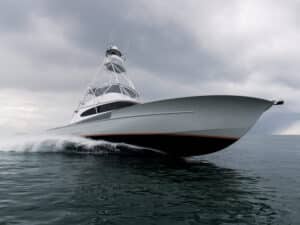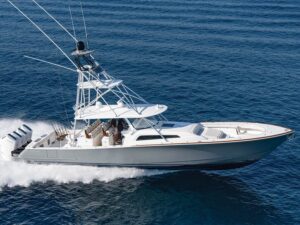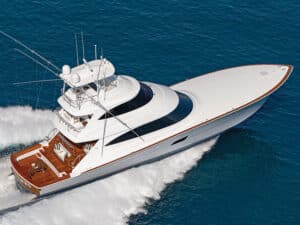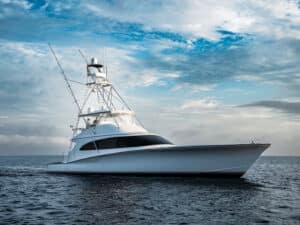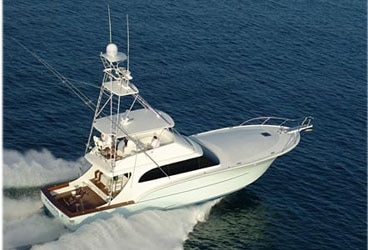
Scully 64 main
Those who know Sculley’s lines from previous models will certainly notice how much more shape the builder has incorporated into its newest offering, the Sculley 64. Everywhere you look, you find radius curves. Even the cabin windows – usually flat glass panels on most boats – have been formed to fit the contours of the cabin.
Sculley builds cold-molded boats using Okume plywood and fiberglass in the hull, and vacuum-bagged Divinycell coring in the superstructure. All this contributes to the Sculley 64’s sleeker profile and excellent performance. However, traditionalists, take note: Certain signature design features you’ve come to know and admire in Sculley’s boats are still here, right down to the high bow and radical turndown shear.
“We don’t want to be the fastest boat,” says builder Jim Sculley. “We want to be the most seaworthy.” Sculley built his reputation building incredibly seaworthy boats – though they certainly aren’t slow, either. In the flat calm of the Intracoastal Waterway, we topped out at 39 knots turning 2,350 rpm.
We picked up the first 64 hull in North Palm Beach on a clear day with winds blowing a full 20 knots out of the north. Anyone who has ever fished Sailfish Alley off Florida’s east coast knows what happens in these conditions. The north wind meets the Gulf Stream, and the seas seem to stand straight up in the air. Seas build and it gets rough rather quickly – perfect sailfish weather and excellent conditions for testing a boat.
Performance
The owner of hull No. 1 plans to keep the boat in the Caribbean and opted not to put any spray curtains on the flybridge. Needless to say, if the Sculley turned out to be a wet boat, we would immediately feel the consequences of his decision. We charged out of Lake Worth Inlet into 3- to 4-foot seas out of the northeast. As I closed on the Gulf Stream, the seas jumped up to 5- and 6-footers. The 64 ran smooth as silk at 30 knots straight into it, and my sunglasses remained spotless. Both up- and down-sea, I found an interesting performance characteristic: The bow never dropped into the next wave but lowered rather gently, almost as if in slow motion. I never felt an impact. Time to plane was about 10 seconds, although the boat actually planed before the turbos spun up to a full boost.
One aspect of the Sculley 64 makes it stand out from other Carolina boats: Sculley and designer Steve French of Applied Concepts Unleashed in Stuart, Florida, offer a much more moderate treatment of bow flare. I found the compromise between sharp entry/pronounced flare and the somewhat blunter Palm Beach-style entry visually satisfying. It still kept its great up-sea performance, and when traveling down-sea the bow lifted over waves better than a sharp entry would. As an added bonus, the design affords considerably more interior space in the forward cabin.
When I cranked on the wheel for a hard-over course change at over 30 knots, the 64 leaned modestly into the turn and carved a most impressive 180-degree arc in about two boat lengths. This boat handles like an aggressive teenager in heavy traffic.
Drifting beam-to in 5- to 6-footers – like you normally would while kite fishing for sails – often proves really uncomfortable for those with queasy stomachs. While the Sculley rolled, the roll moment proved to be long and gentle with no snap transitions.
The designers kept fishing in mind from the first line drawing. They know that the boat’s performance when spinning on a fish or backing down is equally as important as how fast or smooth the boat runs while underway. No matter what I did to elicit a negative performance result, the Sculley exceeded my expectations.
Flybridge
Before I get into the details of the flybridge, let me say that one of my overriding concerns on any boat is safety. This means providing a way to get out of the water if you fall overboard, properly placed handholds, good nonskid where needed and crash pumps attached to the engines. Some owners give little thought to the safety of the crew during a mundane chore such as washing down the boat. Sculley does. A sizable lip encircles the flybridge both at coaming level and halfway down, offering the mate a relatively secure place to stand when washing and drying the outside of the bridge.
While there’s room for a guest to squeeze behind the helm seat, the positioning of the companion chair needs to be changed to allow the guest to move from the back of that seat to its front. A 3-inch platform affords an excellent cockpit view, as well as a view of at least half the bow.
The apostrophe-shaped guest seating area forward of the helm accommodates 10 people quite comfortably.
**Cockpit
**The optional mezzanine on the 54- and 60-foot models comes standard on the 64. All the compartments here are custom-built with stainless-steel boxes in the refrigerators, freezers, salon-step drink box and Eskimo ice bin. Of course, the entire customized cockpit layout reflects the owner’s wishes. This particular hull sports a refrigerated, in-deck fish box that uses about three-quarters of the cockpit width and that also doubles as a 20-below freezer at the twist of a dial.
I personally feel that in the current design, an angler might have difficulty clearing the corners with a standard 7-foot
rod. However, talks are underway to both redesign the chair to accommodate the extra-wide cockpit as well as round off the transom corners to get a bit more space.
The Sculley 64 also provides one of the most expansive overhangs I’ve ever seen. It’s huge, with built-in air conditioning ducts over the mezzanine to help keep you cool down in the islands. The flybridge helm, situated at the extreme aft end of the overhang, affords the captain an unobstructed view of almost the entire cockpit.
The owner of hull No. 1 cruises as much as he fishes, so he opted for a less-hard-core cockpit than most fanatic fishermen would. Sculley allows owners to choose the standard refrigerated transom fish box, livewell, undergunwale power points for electric reels and the like if they want to do more fishing than cruising.
The all-teak covering board proved quite comfortable to brace against while fishing – even without coaming pads. The gunwale met me at just about midknee, which means it will hit most at lower-thigh level.
Engine Room
I accessed the centerline engine hatch by pushing a button for a pneumatic servo that raised it up on a ram. A separate button controls the electric salon door. Beam me up, Scotty!
The engine room just might be my favorite compartment aboard the Sculley 64. With almost 7 feet of headroom and engines spaced far enough apart that I could easily walk between them without turning sideways. Sculley Awlgrips every surface for easy cleaning, and there’s almost enough room outboard of the engines to actually walk a circle around them. Twin Northern Lights generators and a watermaker mount against the forward bulkhead; filters on the outboard bulkhead and cockpit chill box compressors are mounted along the aft bulkhead.
You’ll also be amazed at the amount of dry storage space down there.
Hull No. 1 boasts twin Caterpillar C-32 turbo diesels rated at 1,550 hp, each coupled to Glendinning electronic controls. Bowing to reality, Sculley also inserts a removable centerline panel in the salon floor to facilitate removal of an engine if this ever becomes necessary.
**Accommodations
**While not dramatically different, the salon layout diverges from tradition just enough to keep it interesting. The huge galley, which takes up one-quarter of the salon, sports Corian counters with cherry inlay around the sink, a refrigerator/freezer drawer under the counter along the forward bulkhead, and an obliquely situated island/bar with a four-burner cooktop and two leather-clad barstools.
The entire port side offers seating by virtue of a leather L-shaped settee aft and a dinette banquette just forward of it. The entertainment center with its hideaway, big-screen plasma TV faces the settee.
Cherry seems to have become the interior wood of choice since good teak has become so hard to get – but that doesn’t bother me in the slightest. The almost blond tone of the shade-grown cherry screams elegance, thanks to the superskilled craftsmen at Sculley. The builder contracts out only the tower, engines and electronics; everything else Sculley makes in-house. And I particularly loved the indirect architectural lighting in wooden valances in the salon and throughout. That, and the excellent use of what on most boats amounts to lost dead space.
The new owner probably has lots of kids come along since he chose twin over/underberth guest cabins to port that share a head. The master stateroom to starboard with an athwartship queen berth gets its own private head, and finally the forepeak hosts an elevated double berth affixed obliquely along the port bulkhead with a settee juxtaposed that doubles as a single berth. I’d guess headroom in this cabin to be almost 8 feet. And, of course, there’s storage under every berth, as well as in several bilge compartments. To its credit, Sculley finishes every surface aboard. I found no raw fiberglass anywhere.
Sculley represents one of the new breed of Wanchese boatbuilders willing to flout tradition just enough to take advantage of new technology – without making compromises in performance or style.
